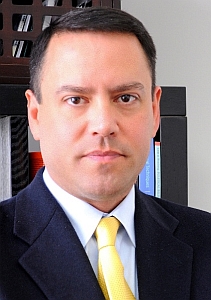Rochester Institute of Technology in New York received a National Science Foundation grant for research on infrared detectors grown on silicon wafers, with potential applications in astronomy, remote sensing, and medical imaging. The $1.2 million award will fund RIT’s development, fabrication, and testing of a new type of detectors grown on silicon wafer substrates by Raytheon Visions Systems in Goleta, California.
The use of infrared detectors has been limited by their high cost, driven in part by the need for cadmium-zinc-telluride wafer substrates. Don Figer (pictured left), director of the Center for Detectors at RIT and lead scientist on the project says, “Right now infrared detectors are so expensive that there are only a few on the world’s biggest telescopes.” Figer adds that “a typical state-of-the-art device has 2,048 by 2,048 pixels at a cost around $350,000 to $500,000,” a significant part of an installation’s budget for instrumentation.
Raytheon Vision Systems develops detection and imaging devices for applications in the x-ray, visible, infrared, terahertz, and millimeter wave spectrum regions. The company says it has delivered more than 450,000 devices for military, scientific, and commercial sensing systems.
The project will examine ways of fabricating infrared detectors on silicon substrates, the material most common to the semiconductor industry. Raytheon has developed a prototype detector technology using a method of depositing light-sensitive material on silicon substrates while maintaining high vacuum throughout the many steps in the process. The material growth is done using a semiconductor industry technique known as molecular beam epitaxy.
Raytheon’s technology overcomes a nagging problem facing past attempts to use silicon substrates, the crystal lattice mismatch between silicon and infrared materials that causes defects. The photo-generated charge that represents the signal can get stuck and lost, or pop out of the lattice and show up as a phantom signal.
RIT and Raytheon plan to design and fabricate arrays with this technology of 1,024 by 1,024 pixels and 2,048 by 2,048 pixels and test them in RIT’s labs. The RIT team will measure the detector performance using a system based on one Figer designed for the Space Telescope Science Institute to measure the performance of detectors to be flown on the James Webb Telescope. The researchers will also develop a new light-tight housing to keep the detector optically and thermally isolated from everything around it, preventing additional noise.
Read more:
- Grant Funds Feasibility Study of Photonic Ethernet Chips
- High-Energy Infrared Beams Adapted for Tabletop X-Ray Device
- Lasers, Electric Fields Aid Lab-on-a-Chip Technology
- Nanolasers Grown on Silicon, Boost New Chip Prospects
* * *


 RSS - Posts
RSS - Posts
You must be logged in to post a comment.